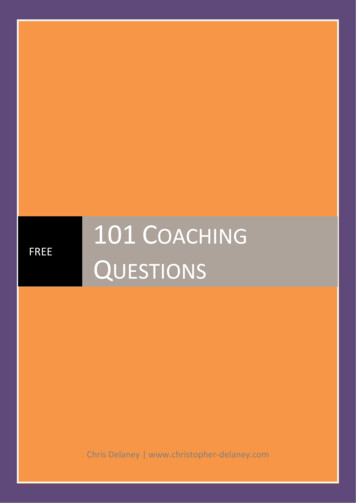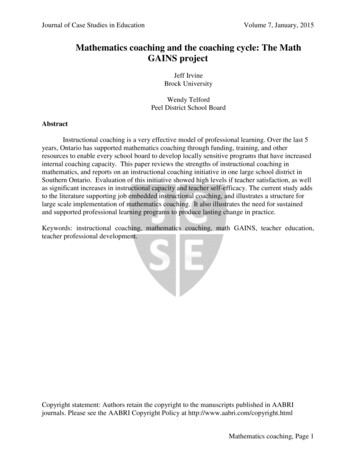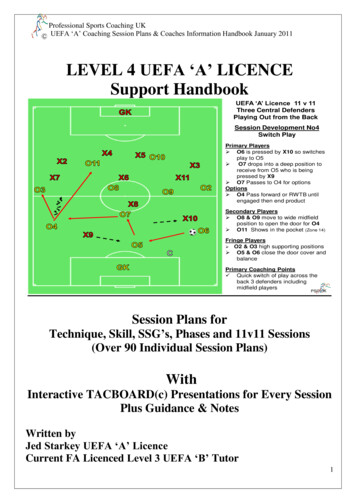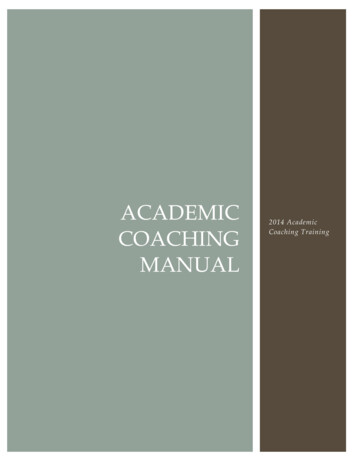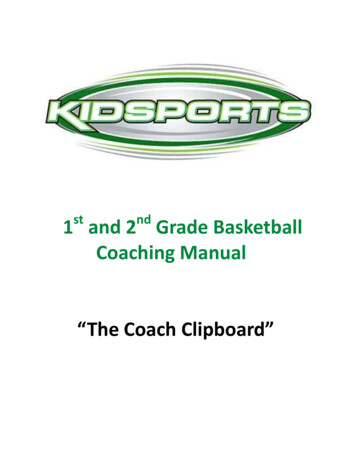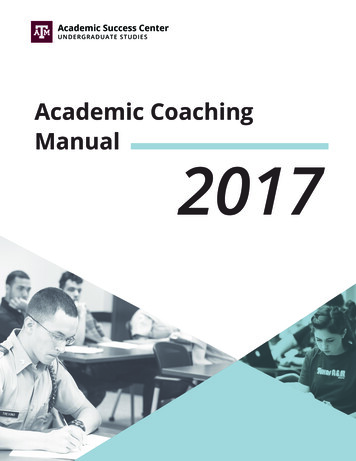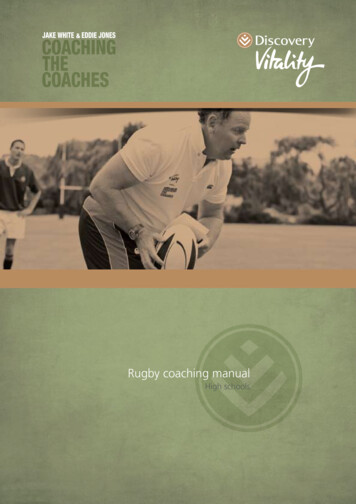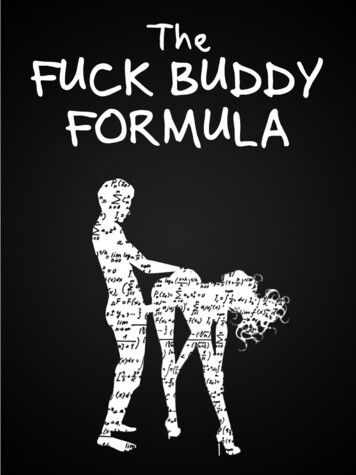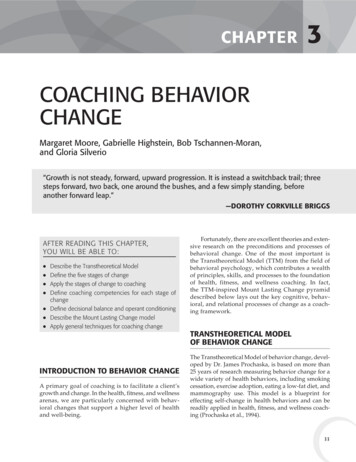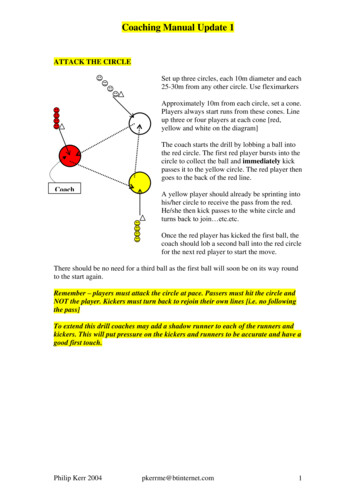
Transcription
Coaching Manual Update 1ATTACK THE CIRCLESet up three circles, each 10m diameter and each25-30m from any other circle. Use fleximarkersApproximately 10m from each circle, set a cone.Players always start runs from these cones. Lineup three or four players at each cone [red,yellow and white on the diagram]The coach starts the drill by lobbing a ball intothe red circle. The first red player bursts into thecircle to collect the ball and immediately kickpasses it to the yellow circle. The red player thengoes to the back of the red line.CoachA yellow player should already be sprinting intohis/her circle to receive the pass from the red.He/she then kick passes to the white circle andturns back to join etc.etc.Once the red player has kicked the first ball, thecoach should lob a second ball into the red circlefor the next red player to start the move.There should be no need for a third ball as the first ball will soon be on its way roundto the start again.Remember – players must attack the circle at pace. Passers must hit the circle andNOT the player. Kickers must turn back to rejoin their own lines [i.e. no followingthe pass]To extend this drill coaches may add a shadow runner to each of the runners andkickers. This will put pressure on the kickers and runners to be accurate and have agood first touch.Philip Kerr 2004pkerrme@btinternet.com1
RUN THE LINE/KICK THE LINEA very simple drill to let players practise solorunning at pace and then delivering an accuratekick pass [hard foot and off the laces] to teammate.The groups are deliberately set close together toshow players how an inaccurate kick can causeproblems.Set out a line of cones approximately 5m apart.Step out 25-30m and set another line of conesopposite the first.Form groups of 3. The first player solo runs at pace to his/her opposite cone, turnssharply round the cone and kicks the ball to the next player in his group. This nextplayer must attack the ball rather than wait for a nice bounce etc.So, it is important that the kick is accurate and not sent high into the air. The playerreceiving the pass must learn to time his/her run and not start too early. A good ideawould be to break once the solo runner has turned round the far cone.If passes go astray, the receiver must still work to get the ball and then solo run to theproper cone etc.Coaches should remind players of the need to maintain good technique in solorunning and in kicking as tiredness sets in.Coaches may also find that letting groups race against each other can mimic matchconditions.Philip Kerr 2004pkerrme@btinternet.com2
STAGGERED ATTACK/DEFENCEAADDSet out ten cones in two lines to form a channel 30-40m wide. Each cone should be10m from the next one in the line. At both ends of the channel place a row of markers[e.g. blue and green].At the mid-cone on each side, start four players. Two are attackers [red, A] and twoare defenders [white, D]. The reds on the right side of the channel have the ball.On the whistle, the reds with the ball sprint to the nearest cone and turn into thechannel to attack. At the same time, the whites on the same side sprint to their nearestcone and turn into the channel to tackle the advancing reds.On the other side of the channel and at the same time, the reds and whites sprint totheir ‘end’ cones and turn to back their team-mates up and form a second wave ofdefenders and attackers.This leads to a 4 v 4 situation, with reds attempting to work the ball across the blueline of markers and the whites trying to win the ball back and work it over the greenline of markers.Encourage attacking players to make support runs and use width but remind them thatthey do not ALL have to touch the ball. Some runs will be to draw defenders awayfrom the ball and create gaps.Encourage defenders to force attackers to break two lines of defence, rather than oneflat line of four.Swap roles and partners after every turn.Philip Kerr 2004pkerrme@btinternet.com3
TWO-WAY PASSINGDiagram 1Diagram 2BBCCDDAASet up three cones in a line, each 30m apart.Place one player at each of the end cones [Blue player, A and Red, B player]Place two players the middle cone [White player, C and Yellow, D player]Red and Blue have a football each.Yellow and White stand back to back, Yellow facing Blue and White facing Red.Diagram 1Whistle starts drill.Yellow breaks for a kick pass from Blue, while White breaks for a pass from Red.Yellow gathers ball and returns the ball to Blue with a fist pass.White does the same to RedDiagram 2Yellow turns immediately to move for another kick pass, this time from Red.White turns to get a pass from Blue.Yellow gathers ball and returns the ball to Red with a fist pass.White does the same to BlueThey turn again etc. etc.Let Yellow and White work hard for one minute, then switch Blue and Red into themiddle and resume.Coach should emphasise that the kick passers are practising accuracy from ‘freekicks’, while the runners are working on speed endurance, angles, first touch andproper fist passing from distance [not short flicks from the hand]Philip Kerr 2004pkerrme@btinternet.com4
THREE STATION WARM-UPThis drill works for any number from 12 to 30. Simply increase the number offootballs used in each of the three drills.Set up two large triangles and one line, using cones or poles. Match colours ifpossible. Superimpose them as shown.The red triangle has sides 30m long. The blue triangle has sides 20m long.The line from black cone to black cone is 40m long.For 12 players:Red Drill – place two players on the starting cone and one on each of the other two.Use one ball from start cone. Players kick pass and follow.Blue Drill – place two players on the starting cone and one on each of the other two.Use one ball from start cone. Players fist pass and follow.Black Drill – place two players on each cone. Use one ball. Players solo run across,fist pass and join opposite line.Start all three drills together and run for three minutes. Break for mobility and lightstretching for one minute. Rotate groups and run for a further three minutes.Break for one minute .Rotate .etc.For 20 players:Use two balls for each drill. Start the footballs at different stations.Coach must emphasise the need to increase intensity, particularly in final drill.Philip Kerr 2004pkerrme@btinternet.com5
THREE SQUARE SPEED ENDURANCEThis is a speed endurance drill with no ball being used. It is vital that rests aregiven between runs and between sets.Set out a large square [blue] with four cones/poles at corners. Each side shouldbe 40m long. No need to set lines of markers – just cones at corners.Set out a middle square [red] with four cones/poles at corners. Each sideshould be 30m long.Set out a small square [green] with four cones/poles at corners. Each sideshould be 20m long.Place runners on each of the four corners of each square [e.g. 3 on each cornerwill allow 36 to take part].All will run the perimeter of their own squares as follows:Jog 3 sides, then sprint 1 side.Rest for 20 seconds.Jog 2 sides, then sprint 2 sides.Rest for 40 seconds.Jog 1 side, then sprint 3 sides.Rest for 60 seconds.Sprint 4 sides.Rest for two minutes.This constitutes one set.Those on the small square will have jogged 120m and sprinted 200m: Thoseon the middle square will have jogged 180m and sprinted 300m: Runners onthe large square will have jogged 240m and sprinted 400m.Swap squares for the second and third sets, so that all players do the samework. By the end of the exercise each player will have jogged 540m andsprinted 900m. It should take no more than 20 minutes to run properly.Philip Kerr 2004pkerrme@btinternet.com6
OFF THE LACES, THROUGH THE GATEBASet up two posts [e.g. rounders posts] 5 metres apart. This is the gate.Set out one cone, facing the gate, 10-20m away.Put the second cone on the other side of the gate and offset by 10-15m [seediagram.Four players at first cone – each with a ball; four at second cone – no footballsFirst Red, A, calls for a pass. White, B, kick passes through the gate for Red torun onto the pass and take it a pace [ball must be kicked through the gate –NOT directly at the receiver].Red gathers the ball and solo runs left of the gate to join the White line.White follows the kick and runs left of the gate to join Red line.Once the gate is clear each time the next receiver call and the ball is kickedetc.Run the drill for approx. 3 minutes.Coaches must stress the need for players to work at pace, maintain goodkicking technique even when fatigue sets in and time runs for the pass.Kicking ‘off the laces’ is best [i.e. toe down, head down when the ball isstruck]After a rest, change the angle of the receiver’s run, by shifting the secondcone to a different spot.Philip Kerr 2004pkerrme@btinternet.com7
CALL THE COLOURHABCSet the coloured cones 15-30m from goals and 3m apart.Set out a line of markers 3m behind the coloured cones.Set a single cone 15m behind the markers.Start 4 players [each with a ball] at the single cone and 4 players near thegoals.First player solo runs from the white cone towards the line.As he/she reaches the line of markers the coach calls a colour [red, A, yellow,B, or blue, C].Player must react quickly to shoot for a point from that cone.The shot for a point is the signal for the next player to start a solo run etc. etc.Players near the goal simply retrieve and return footballs to those playerstaking shots. Rotate groups after 5 minutes.This drill helps players work on the quick reactions needed to make space fora shot. Coaches should encourage players to use left and right feet whenshooting, rather than try to hit awkward shots off the outside of the boot.Remember – head down, toe down.Philip Kerr 2004pkerrme@btinternet.com8
LATE RUN & SCOREHEDBACSet up two circles of markers – each 5m diameter and about 10-15m from goal.Set out a line of markers between two cones – 30m long and 40-60m from goal.Take 12 players and make 3 groups of 4.On the whistle, the first yellow player, A, solos along the line.Coach calls ‘NOW’ and the player turns quickly to kick pass towards the first greenplayer, B, who breaks from the circle.The green player takes the ball, turns quickly and shoots.The shot is the signal for the first red player, C, to solo, coach calls ‘NOW’, red turnsto pass to the first blue, D, etc. etc.Passers [reds, C, and yellows, A,] simply cross over each time along the line.Shooters [greens, B, and blues, D] swap shooting positions each time.Retrievers [whites, E,] return the footballs to passers.Groups swap every few minutes.Coaches must emphasise the following:The shooters may jog about inside the circle, waiting for the call and kick. Theymust work hard on holding for as long as possible and then breaking out of thecircle as late as possible [i.e. just as the ball is about to be kicked]. This is done tosimulate good forward play, where he/she has one chance to break away from amarker.All runs, passes and shots must be AT MATCH PACE, once players have becomeaccustomed to the drill.sPhilip Kerr 2004pkerrme@btinternet.com9
SAVE OR SCORE?HADADDSet up two yellow cones – one on the end line about 10m from the goalpost, the otherabout 25m from it, straight out the pitch.Set up two red cones – one on the end line about 10m from the goalpost, the other25m from it, running at a sharp angle towards the point where the 13m line meets thesideline.The two white players, A, are attackers and start on the end line cones. The blueplayers, D, are made up of the goalkeeper and two defenders. The defenders start onthe outfield cones.The white player on the yellow cone has the ball.On the whistle, the whites sprint from the endline cones to the outfield cones and turnto attack. The white player with the ball should solo run at pace.At the same time, the blues sprint from the outfield cones to the endline ones and turnto defend.The thin black arrows represent the white movement and the thick black arrows showthe blue movement.Whites try to combine [or perhaps not] to score a goal past the ‘keeper. Blues mustwork out how best to defend and stop this.The move is over when the whites score or hit a wide or the goalkeeper saves or thedefenders intercept.Have another group of 4 players ready to start [or even a couple of groups] when thismove finishes. Swap roles and positions after each attempt.Coaches should watch how players work together. This usually shows up lots offaults re. where to move, when to move, change of pace, how to protect the goal,who to mark or tackle etc. Coaches must take time to help players improve in theseareas.Philip Kerr 2004pkerrme@btinternet.com10
SPEED ENDURANCE MIXUse cones or poles to set out three overlapping running tracks as shown:Place four red cones to form a square with 30m sides.Place three blue cones to form a triangle with 40m sides.Place four green cones to form a rectangle 50m long x 10m wide.Each track, therefore, is 120m long.Divide your squad into 3 groups. Let’s say you have 10 in each group.Start the red group on the four corners of the square [2, 2, 3, 3]Start the blue group on the three points of the triangle [3, 3, 4]Start the green group on the four corners of the rectangle [2, 2, 3, 3]On the whistle everybody completes 1 lap of their track as fast as possible. Runthem clockwise. This will take approx. 25-30 seconds. THIS RUN IS CALLED AREP.Let them rest for a full minute on the clock as they walk to the next shape andcolour [e.g. reds to blue / blue to green / green to red].Run them again on the whistle and rest for a minute.Switch once more and run again to finish the three colours and shapes. Eachplayer will have covered 360m. THIS IS CALLED A SET. [3 reps in a set.]Rest everyone for a full two minutes this time and then repeat the set, completewith proper rest periods. Run them anticlockwise this time and think aboutswapping players between groups to break up mates.This type of overlapping speed endurance drill has one main advantage. Players areunaware of how well other groups are doing, so they work harder. Coaches mustremember that any work like this is best done EARLY in the session and withproper rests between reps and sets.Philip Kerr 2004pkerrme@btinternet.com11
STAGGERED RACES [for Speed/Speed Endurance]lineABCACBA simple drill to work on different mixes of sprints and turns.Space out three cones along a sideline, 45m line or end line [red, A, yellow, B andblue, C].Step out 14m exactly from the red and set another red.Step out 25m exactly from the blue and set another blue.Step out 40m exactly from the yellow and set another yellow.Let’s say you have 12 players working on the speed drill.The first four should stand at the red cone that is NOT on the line.The next four should stand at the yellow cone that IS on the line.The last four should stand at the blue cone that is NOT on the line.On the whistle all three groups race as follows:Reds sprint 5 legs [in-out-in-out- in to finish on the line]Yellows sprint 2 legs [out-in to finish on the line]Blues sprint 3 legs [ in-out-in to finish on the line].Reds will have run 70m, blues will have run 75m and yellows will have covered 80m.There should be a close finish to the race because reds may have the shorter distance,but they have four turns to make; blues have two turns to make, while yellows havethe longest run, but only one turn to make.Rest for 1 minute between races [reps], switch colours and run three races altogetherto make a set. [each player will have covered 225m in a set]. Run two sets.Coaches must remember that any work like this is best done EARLY in the sessionand with proper rests between reps and sets.Philip Kerr 2004pkerrme@btinternet.com12
EVADE & PASSACBD30-40mSet out two lines of fleximarkers 30-40m apart.Choose 4 players. Green, A, and White, B, are teammates. Yellow, C, and Red, D, areteammates.Green has the ball. Yellow faces Green from across the line. White waits for Green’spass on the far side of the other line. Red rests.Start with Green trying to evade Yellow and hit a good kick pass to White, whomoves out to gather the ball. Green should use a feint and side-step or a roll to findspace to deliver a pass. White must watch for this and time his/her run to receive theball.When White collects, he/she turns sharply to fist pass over the line of markers to Redand then stands facing Red as an opponent [just as Yellow did for Green].Meanwhile, Yellow has moved to the far side of the other line of markers and Greenrests.Red evades White to find space for a long kick pass to Yellow, who moves out togather the ball.White turns and fist passes to Green, etc. etc.After a couple of minutes, swap roles and partners to give all players the opportunityto practise evasion, kick passing, timing support runs, receiving the ball cleanly andturning sharply.Coaches must insist that passers evade at speed. They should not let players awaywith simply ballooning the ball into the air to cover the 30-40m.Coaches must also watch for receivers who break too early [when the kicker hasn’teven made space.]Philip Kerr 2004pkerrme@btinternet.com13
CROSS THE GAPBDD2B2C2A2AC25-30mFour pairs of player, two on either side of the gap; greens play with whites, blues withreds.Start a ball with the reds, A, and a ball with the whites, B. Red, A, hits a kick passacross the gap [no high ball] and a blue receives, C. The other blue player, C2, runs tosupport the receiver [off the shoulder] and take a fist pass on the burst.He/she must immediately kick pass across the gap to a red receiver, A2 etc. etc.As this goes on, the same happens between the greens, D, and whites, B.The keys to the success of this drill are: The passes must be hit properly [driven across the gap, no more than 2-3mabove the ground]As the pass is hit, the players must decide quickly who will receive and whowill supportThe support runner must learn to peel off and make a late run to take the ballon the burst, rather than stay too close to the receiver when the ball arrives.Coaches will find that the latter is the hardest to coach. Support runners tend to runtowards the receiver even when the ball is in flight. It often runs counter to theirinstincts to actually move away to create a distance and then burst when it is mosteffective.Philip Kerr 2004pkerrme@btinternet.com14
SPRINTS & STEPS864A simple drill to work on different mixes of sprints and steps [fast feet].Set up the following pattern and repeat it as often as you see fit. The diagram shows 4of these patterns.Set out a short line of fleximarkers as a start line [e.g. four of them].Step out 20m and lay a pole [e.g. bamboo stick or training pole – 2m long] on its flatas shown.Step another 15m and do the same. Step another 10m and do likewise.Start a player behind the line of markers. On the whistle he/she sprints the 20m to thepole and steps rapidly over and back across the pole 8 times [i.e. 4 over and 4 back].He/she then races on over the next 15m and steps over and back 6 times at the nextpole. The last sprint is 10m long and there are 4 steps to complete at the final pole.This is a 45m run, punctuated by 18 fast feet rep. Rest period is afforded by the walkback to the start.When the first player in the drill has cleared the first pole, the next in line may start.If a coach sets up 4 such courses [as in the diagram] up to 20 players may beaccommodated.Coaches must stress the need for 100% sprint work over all three distances. Playerswill tend to flag on the last leg.Philip Kerr 2004pkerrme@btinternet.com15
A good idea is to run 3 sets of these [3 runs in a set], with a drinks break of oneminute between each setFORWARD / BACKWARD LINES20m15m10mA simple drill to work on different mixes of forward and backward sprints.Line four players up at the cones as shown. In front of them lie lines of fleximarkers[red, blue, black and green for the purposes of the diagram].Make sure to vary the distances between each line.The coach calls a combination of colours and the players must sprint to the colours inthe order called. Should one of the colours mean that players have to run back toreach it, then this sprint should be done backwards [i.e. still facing forward – good forhamstrings and to copy back pedalling during a game].So, the coach calls BLACK, BLUE, GREEN”. Players sprint to cross the black line,run backwards to cross the blue line and finish with a forward sprint to cross the greenline. In this example the players will cover 75m in total.Calling the colours ‘BLUE, RED, GREEN, BLACK’ will see each player cover 95mper run.Rest is based on the walk back to the start and lining up behind other groups. Thesecond group of four players may run their combination as the first group walks back[leave ample room for this].This drill is best run with 12-16 players and early in the session [e.g. after anextensive warm-up with the ball].Philip Kerr 2004pkerrme@btinternet.com16
WIPEOUT [Game]A game to try as part of a series:Choose two teams [e.g. 7v7 up to 15v15], bib them and adapt the size of the pitch tosuit.The game is normal Gaelic football with one twist. To win the game, a team mustscore 3 times consecutively [without their scores being interrupted by an oppositionscore]. Should the opposition score before 3 consecutive scores are taken, any scoresearned are wiped out and the opposition are now deemed to be winning 1-0.e.g. Team A scores a point and then a goal. They are now winning 2-0 in scores taken.Team B scores a point. Team A’s two scores are wiped out and Team B leads 1-0.The first team to reach score consecutive times wins the game and goes 1-0 up in theseries. Run the series to suit [e.g. series is over when one team wins five games].A modification of this involves delaying the ‘wipeout’ element until a certain numberof scores has been reached.e.g. Teams play first to get five scores on the board, but ‘wipeout’ rules only applyafter 4 scores. So, both teams keep playing and scoring as normal until one reachesfour scores. Should this team manage a fifth without the opposition scoring first, itwins the game. However, should the opposition score, the four scores are wiped out.Why bother play this game? It focuses players much more and leads to a higherdegree of intensity. Players are keener to defend, to find space, to shoot sooner andto turn the ball over.Philip Kerr 2004pkerrme@btinternet.com17
October UpdatesSTEP, SPACE, SCOREBHACCBAA drill to let players practise soloing towards goal, stepping into the tackler tomake room and then shooting for a point:Organise three groups of players [e.g. 6 reds, A, 6 yellows, B, and 6 whites, C].Take two from each group and send them behind the goals to retrieve footballs.Set out three cones about 30m from goal and at different angles. Beside each coneplace a pole. Groups choose a cone/pole each from which to start. Each pair shouldhave a football.Focus on the yellow group on the diagram. One player takes a ball and stands at thecone. Another stands at the pole. The remaining two wait their turn to do the same.The solo runner [player at cone] and the shadower [player at pole] run at pace towardsthe goal. The shadower runs tight to the solo runner but does not tackle.At some point along the run the solo runner must step into the shadower to makeroom for the shot. The shadower must provide stiff resistance without charging orshouldering. The solo runner must make the shoulder-to-shoulder contact.Once room has been made, the solo runner must shoot for a point.Both players follow on to the end line. The ball is retrieved by the yellows behind thegoal and carried out to the start. Meanwhile the other two yellows who were waitingtheir turn [at the cone/pole] start the exercise.Reds and whites do the likewise at the same time.Philip Kerr 2004pkerrme@btinternet.com18
The key is to ensure that solo runners do not step away from the shadower and arenot forced to change the angle of their runs just because an opponent in runningalongside them [most players do this subconsciously and end up kicking the ballwide]. This drill is designed to work against those instincts.THREE TO SCOREOne piece of Gaelic game analysis suggests that winning teams keep up anaverage of at least one score for every three times they take possession of the ballin the opposition half of the pitch. Anything less often spells defeat.This game is designed to simulate such conditions and force players to work tokeep up the scoring rate.Set up a pitch to suit numbers on each team, and then run a line of fleximarkersalong the halfway line.Let players take part in a game with normal rules.Point out that each team STARTS with a score of 3.For each time that a team attacks [i.e. takes possession in the opposition half]and does not score, 1 is taken off the starting score of 3.The first team to have its score reduced to 0 loses that game [usually one of aseries of games set by the coach].If a team scores before the 3 becomes 0, the rate is maintained and a new ‘3’ isawarded.e.g.Team A misses with its first shot and has its score reduced to ‘2’.The next attack from Team A is turned over and the score is cut to ‘1’.Team A now has one last chance to score.Team A scores on the next attack. The team’s score is set at ‘3’ again and thegame goes on.So, each time a team scores, the score is reset at ‘3’.Try this game and see how it focuses players. At first you may find it leads to alot of tight fist passing as players attempt to keep possession. However, theyshould learn quickly that such a method of play will allow the opposition toregroup and spoil attacks more easily. Soon they’ll find that a more direct styleof play [with quick support to front players] is best.Philip Kerr 2004pkerrme@btinternet.com19
SCORES AND TURNOVERSHere’s a game to focus players on working harder to turnover the ball duringplay. It is particularly useful for coaches who are keen to improve forwards’work rate when the opposition has the ball.Play normal Gaelic rules. Set up a pitch to suit the number of players. Run a lineof fleximarkers across the halfway line.To win one game in a mini-series [e.g. best of five] a team may either score fourtimes or turn the ball over twice inside the opposition half.A ‘turnover’ is only awarded for an interception during play, a tackle that winspossession, a block that leads to possession.If a team manages to turn the ball over, play does not stop; rather it continuesuntil the next break in the game [e.g. score, wide, free, sideline]So, a team that finds itself 3-0 down in scores and with 1 turnover earned, maystill win the game if one of its players forces one more turnover in the oppositionhalf of the pitch.Such a situation will also highlight the need for defenders to make sure the ball isnot lost inside the defending half of the pitch.If players respond by working a tight fist-passing game, they may find that thisleads to even more opportunities for the opposition to turn the ball over.If they decide to simply kick the ball into the other half to avoid the turnover, itinvites another attack from the opposition team.The right balance must be found between keeping possession and delivering atelling pass into the other half for a teammate.To those who complain that the scoring team is being unduly punished,remember the game is deliberately designed to force a higher work rate fromattackers when opposing defenders have the ball. Forwards are being given anincentive to win the ball back.Coaches are free to change the ratio of scores to turnovers [e.g. to win, a teamneeds 3 scores or 2 turnovers].Philip Kerr 2004pkerrme@btinternet.com20
TOUCH & TURNA speed/reaction exercise for 4-6 players in a small area:Set out 8 tall poles in a random fashion, with approximately 2m between each.Around these, in a circle, set 8 cones. The shortest distance between any pole andany cone must be 5m.Ask a group of players [4-6 in number] to stand inside the ‘poles’ area. On thewhistle, each player must sprint to a cone, touch it sprint to a pole, turnsharply around it, sprint to a different cone, touch it .sprint to a different poleetc. etc.Players must run ‘head up’, scanning the area ahead and about them for otherplayers and making sure they use evasion to avoid collisions.Coaches may wish to compare the runs to those in a match where a ball breaksand a player has to make a 5m burst to get to it .or to a situation where anopponent is making a sharp turn and has to be tracked.The coach should time the exercise to run for 20 seconds. After 20 seconds, thegroup should rest, while a second group takes up the challenge.As groups work through the exercise, the coach should reduce the time by 5seconds each time:1st run – 20 seconds2nd run – 15 seconds3rd run – 10 seconds4th run – 5 seconds5th run – 10 secondsPhilip Kerr 2004pkerrme@btinternet.com21
6th run – 15 seconds7th run – 20 secondsBy the end of the exercise each player will have completed 7 sprint patterns over95 seconds [with recovery built in].FRONT TACKLE [DELAY & DENY]B15mmiddle zonemiddle zoneAAn exercise to work on closing down a player on the ball, in order to delayhim and deny him space; it will also promote use of evasion techniques in asmall area.Set out two channels of fleximarkers, each 5m wide and 15m long [shown asRED and GREEN on diagram]. Split each channel into thirds with markers setacross [shown as black on diagram]. At the ends of each channel, line up twoplayers [8 in total].First red player, A, solo runs at pace into middle zone, trying to make itthrough and across to the far zone. First white player, B, moves to meet anddelay the runner in the middle zone, trying to force him outside the channelarea.The tackler must delay the runner and deny space, rather than rush headlonginto a challenge that leaves him floundering and the runner making it past tothe far zone.The tackler makes most mistakes when foot position is not right and he iseasily brushed aside or evaded. Too many play
Coaching Manual Update 1 ATTACK THE CIRCLE Set up three circles, each 10m diameter and each 25-30m from any other circle. Use fleximarkers Approximately 10m from each circle, set a cone. Players always start runs from these cones. Line up three or four pl
